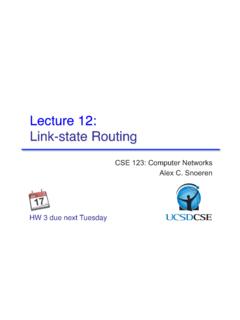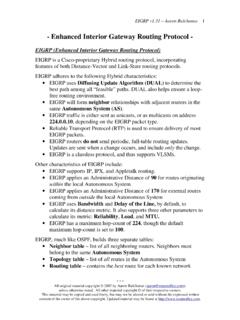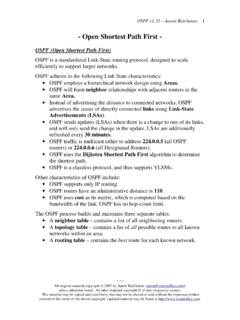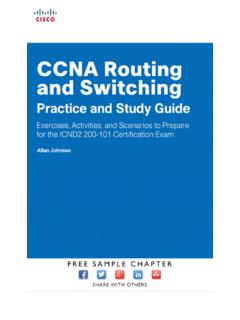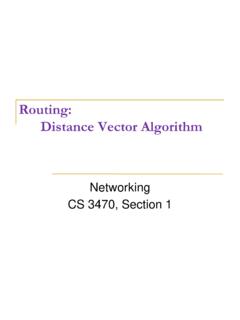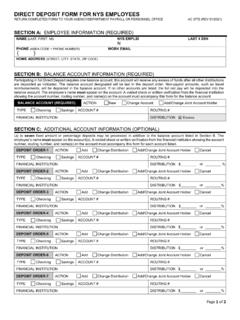Transcription of 6.02 Practice Problems: Routing - MIT OpenCourseWare
1 Practice Problems: Routing IMPORTANT: IN ADDITION TO THESE PROBLEMS, PLEASE SOLVE THE PROBLEMS AT THE END OF CHAPTERS 17 AND 18. Problem 1. Consider the following networks: network I (containing nodes A, B, C) and network II (containing nodes D, E, F). every 5 time steps, all links are fully functional and there is no delay in the links. Nodes take zero time to process advertisements once they receive them. The HELLO protocol runs in the background every time step in a way that any changes in link connectivity are reflected in the next DV advertisement. We count time steps from t=0 time steps. Please fill in the following table: The Distance Vector Protocol described in class is used in both networks.
2 Assume advertisements are sent A. Event Number of time steps A's Routing table has an entry for B A's Routing table has an entry for C D's Routing table has an entry for E F's Routing table has an entry for D A's Routing table has an entry for B: 5 time steps A's Routing table has an entry for C: 10 time steps D's Routing table has an entry for E: 5 time steps F's Routing table has an entry for D: 5 time steps B. Now assume the link B-C fails at t = 51 and link D-E fails at t = 71 time steps. Please fill in this table: Event Number of time steps B's advertisements reflect that C is unreachable A's Routing table reflects C is unreachable D's Routing table reflects a new route for E 1 of 15 B's advertisements reflect that C is unreachable: 55 time steps A's Routing table reflects C is unreachable: 55 time steps D's Routing table reflects a new route for E: 75 time steps Problem 2.
3 Alyssa P. Hacker manages MIT's internal network that runs link -state Routing . She wants to experiment with a few possible Routing strategies. Of all possible paths available to a particular destination at a node, a Routing strategy specifies the path that must be picked to create a Routing table entry. Below is the name Alyssa has for each strategy and a brief description of how it works. MinCost: Every node picks the path that has the smallest sum of link costs along the path. (This is the minimum cost Routing you implemented in the lab). MinHop: Every node picks the path with the smallest number of hops (irrespective of what the cost on the links is). SecondMinCost: Every node picks the path with the second lowest sum of link costs.
4 That is, every node picks the second best path with respect to path costs. MinCostSquared: Every node picks the path that has the smallest sum of squares of link costs along the path. Assume that sufficient information ( , costs, delays, bandwidths, and loss probabilities of the various links) is exchanged in the link state advertisements, so that every node has complete information about the entire network and can correctly implement the strategies above. You can also assume that a link 's properties don't change, , it doesn't fail. A. Help Alyssa figure out which of these strategies will work correctly, and which will result in Routing with loops. In case of strategies that do result in Routing loops, come up with an example network topology with a Routing loop to convince Alyssa.
5 Answer: All except SecondMinCost will work fine. To see why SecondMinCost will not work: consider the triangle topology with 3 nodes A, B, D, and equal cost on all the links. The second route at A to D is via B, and the second best route at B to D is via A, resulting in a Routing loop. B. How would you implement MinCostSquared in a distance-vector protocol? To implement MinCostSquared, your integrate_announcement routine would add the square of the link cost (instead of just the link cost) to any route costs advertised over that link . Problem 3. Which of the following tasks does a router R in a packet-switched network perform when it gets a packet with destination address D? Indicate True or False for each choice.
6 A. R looks up D in its Routing table to determine the outgoing link . True. 2 of 15 B. R sends out a HELLO packet or a Routing protocol advertisement to its neighbors. False. C. R calculates the minimum-cost route to destination D. False. D. R may discard the packet. True. Problem 4. Alice and Bob are responsible for implementing Dijkstra's algorithm at the nodes in a network running a link -state protocol. On her nodes, Alice implements a minimum-cost algorithm. On his nodes, Bob implements a "shortest number of hops" algorithm. Give an example of a network topology with 4 or more nodes in which a Routing loop occurs with Alice and Bob's implementations running simultaneously in the same network.
7 Assume that there are no failures. (Note: A Routing loop occurs when a group of k 1 distinct nodes, n_0 , n_1 , n_2 , .., n_(k-1) have routes such that n_i's next-hop (route) to a destination is n_(i+1 mod k). In the picture below, the grey nodes (A in particular) run Bob's algorithm (shortest number of hops), while the white nodes (B in particular) run Alice's (minimum-cost). Suppose the destination is E. A will pick B as its next hop because ABE is the shortest path. B will pick A as its next hop because BACDE is the minimum-cost path (cost of 4, compared to 11 for the ABE path). The result is a Routing loop Problem 5. Consider the network shown below. The number near each link is its cost. 3 of 15 We're interested in finding the shortest paths (taking costs into account) from S to every other node in the network.)
8 What is the result of running Dijkstra's shortest path algorithm on this network? To answer this question, near each node, list a pair of numbers: The first element of the pair should be the order, or the iteration of the algorithm in which the node is picked. The second element of each pair should be the shortest path cost from S to that node. To help you get started, we've labeled the first couple of nodes: S has a label (Order: 0, Cost: 0) and A has the label (Order: 1, Cost: 2). A: order = 1, cost = 2 E: order = 2, cost = 3 B: order = 3, cost = 4 C: order = 4, cost = 5 D: order = 5, cost = 6 Problem 6. Consider any two graphs(networks) G and G' that are identical except for the costs of the links. Please answer these questions.
9 A. The cost of link l in graph G is c_l > 0, and the cost of the same link l in Graph G' is k*c_l, where k > 0 is a constant and the same scaling relationship holds for all the links. Are the shortest paths between any two nodes in the two graphs identical? Justify your answer. Yes, they're identical. Scaling all the costs by a constant factor doesn't change their relative size. B. Now suppose that the cost of a link l in G' is k*c_l + h, where k > 0 and h > 0 are constants. Are the shortest paths between any two nodes in the two graphs identical? Justify your answer. No, they're not necessarily identical. Consider two paths between nodes A and B in graph G. One path takes 3 hops, each of cost 1, for a total cost of 3.
10 The other path takes 1 hop, with a cost of 4. In this case, the shortest path between nodes A and B is the first one. Consider k=1 and h=1 and compute the costs and shortest paths in G'. Now the 3-hop path has cost 6 and the 1-hop path has cost 5. In G' the shortest path is the second path. 4 of 15 Problem 7. Dijkstra's algorithm A. For the following network an empty Routing tree generated by Dijkstra's algorithm for node A (to every other node) is shown below. Fill in the missing nodes and indicate the order that each node was added and its associated cost. For reference, node C's completed Routing tree is shown as well. 5 of 15 B. Now assume that node F has been added to the network along with links L1, L2 and L3.











